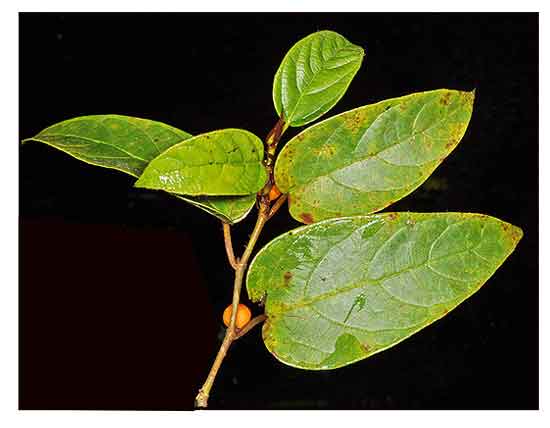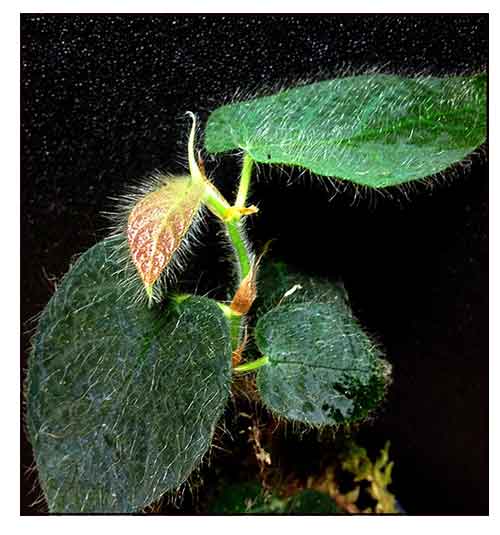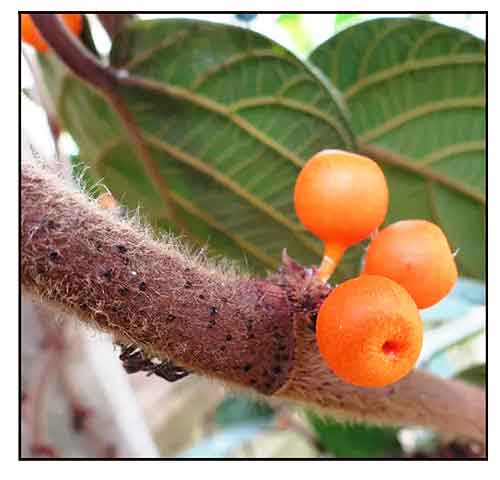
Family • Moraceae
Villous fig
Ficus villosa Blume
SHAGGY LEAF FIG
| Scientific names | Common names |
| Ficus barbata Wall. ex Miq. | Shaggy leaf fig (Engl.) |
| Ficus barbata var. glabriuscula Miq. | Shaggy leaf climbing fig (Engl.) |
| Ficus dives Miq. | Shaggy-leaved fig (Engl.) |
| Ficus grossivensis Miq. | Velvet fig (Engl.) |
| Ficus hirsuta Wall. ex Miq. | Villous fig (Engl.) |
| Ficus jaroensis Merr. | |
| Ficus lagunensis Merr. | |
| Ficus propinqua Merr. | |
| Ficus rupestris Blume | |
| Ficus villosa Blume | |
| Ficus villosa var. appressa Corner | |
| Ficus villosa var. subglobosa Corner | |
| Ficus villosa var. tonsa Corner | |
| Ficus villosa is an accepted species. KEW: Plants of the World Online | |
| Other vernacular names |
| FRENCH : Figuier á feuille velue. |
| MALAYSIA: Kelo. |
• F. villosa is a climbing vine that is reported to reach 2.4 m in length in the home garden, but in the wild, it will grow several feet high on trees. When fully mature, its alternate, stalked leaves have thick, leathery blades up to 30cm long with sunken venation on the upper surfaces. The heart-shaped, hairy juvenile leaves measure about 3-6 cm, and have a reddish colour which fades to green as the leaf matures. The stems of F. villosa are woody and release latex when cut. Flowers are small, inconspicuous and cream-colored and develop into round orange fruits. (5)
Constituents Properties Studies Availability |
July 2025
![]()
 |
| Â Â Â Â Â Â Â Â Â Â Â Â Â Â Â Â Â Â Â Â Â Â Â Â Â PHOTOS / ILLUSTRATIONS |
| IMAGE SOURCE: Moraceae : Ficus villosa / LeLiana with figs / Photograph taken with support from the Philippine Eagle Foundation, LGU and DENR Apayao / Copyright © 2024 by P B Pelser & J F Barcelona (contact: pieter.pelser@canterbury.ac.nz) [ref. DOL252082] / Non-Commercial Use / Click on image or link to go to source page / Phytoimages.siu.edu |
| OTHER IMAGE SOURCE: Ficus villosa / © Black Jungle Exotics! / Non-commercial use / Cliick on image or link to go to source page / Black Jungle Exotics! |
| OTHER IMAGE SOURCE: Ficus villosa from Sabah / © uluulublog / Non-commercial use / Image modified / Cliick on image or link to go to source page / THE FIGS OF BORNEO |
Additional
Sources and Suggested Readings |
• |
DOI: It is not uncommon for links on studies/sources to change. Copying and pasting the information on the search window or using the DOI (if available) will often redirect to the new link page. (Citing and Using a (DOI) Digital Object Identifier) |
| Â Â Â Â Â Â Â Â Â Â Â Â Â Â Â Â Â Â Â Â Â Â Â Â Â Â Â Â Â Â List of Understudied Philippine Medicinal Plants |
| Â Â Â Â Â Â Â Â Â Â Â Â Â Â Â Â Â Â Â Â Â New plant names needed The compilation now numbers over 1,500 medicinal plants. While I believe there are hundreds more that can be added to the collection, they are becoming more difficult to find. If you have a plant to suggest for inclusion, native or introduced, please email the info: scientific name (most helpful), local plant name (if known), any known folkloric medicinal use, and, if possible, a photo. Your help will be greatly appreciated. |
• |
 |




